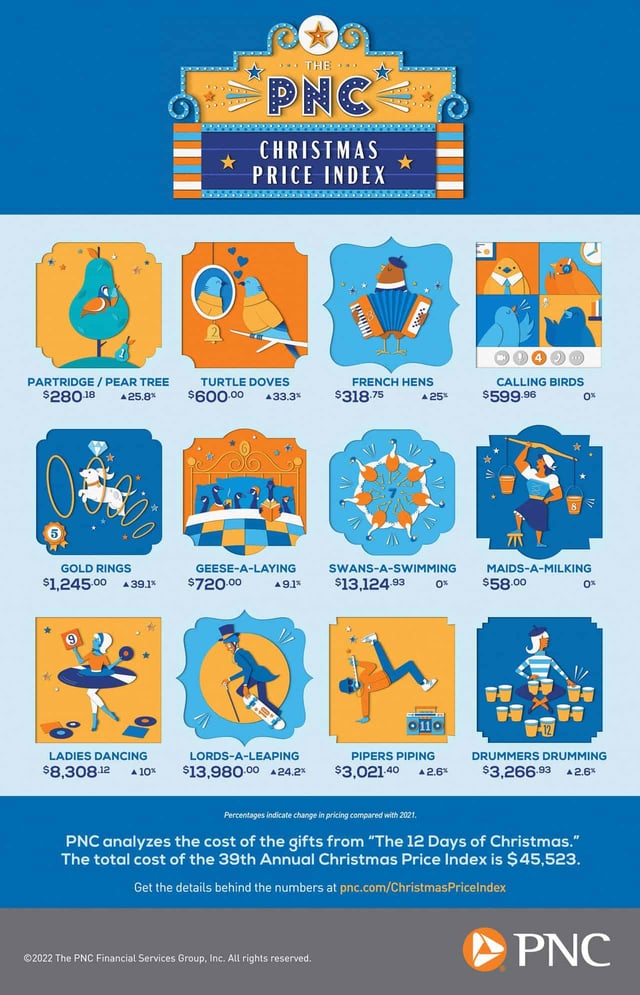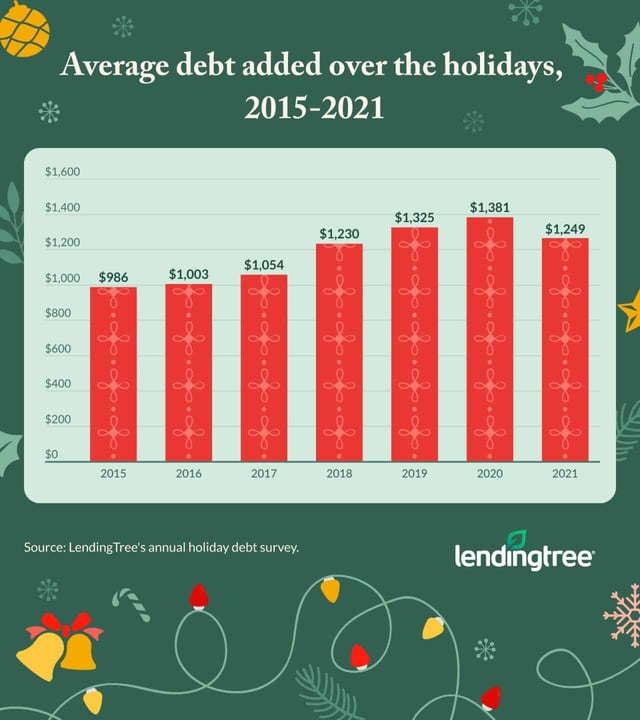
Opinions expressed here are ours alone, and are not provided, endorsed, or approved by any issuer. Our articles follow strict editorial guidelines and are updated regularly.
Christmas is an exceptionally popular holiday. A 25-year Gallup poll found that more than 90% of US adults surveyed participate in this annual December celebration.
The near-universal enjoyment of Christmas includes people of all types, regardless of gender, age, income, and educational background. Christmas is so beloved it even crosses the political divide between Republicans and Democrats, Gallup found.
For many, Christmas remains primarily a religious holiday. For others, it’s all about the elegantly wrapped gifts, seasonal decor, scrumptious foods, and intoxicating beverages. In other words, Christmas shopping.
And with all that shopping, it’s no surprise that Christmas is also strongly associated with spending and debt. These seven surprising statistics tell that part of the Christmas story.
1. ‘The 12 Days of Christmas’ Gifts Cost $45,423
That’s not a typo. For almost 40 years, PNC has calculated and totaled up the prices of the 12 gifts from the classic song “The Twelve Days of Christmas.” For 2022, the total for one of each gift comes to $45,423. Buying the 364 gifts you’d need to complete all of the song’s verses would cost $197,071 this year.

The most expensive gifts this year are the 10 lords-a-leaping, which cost $13,980, or $1,398 per lord, and the seven swans-a-swimming, which cost $13,125, or $1,875 per swan.
Least expensive are the eight maids-a-milking, which cost just $58, or $7.25 per maid. That’s based on the federal minimum wage, which has been unchanged since 2009.
The cost of many of the 12 gifts rose sharply this year due to inflation. That could serve as a cautionary tale for Christmas shoppers buying less esoteric gifts, like clothing, electronics, and toys.
2. 44% of Shoppers Believe the Best Deals Come in October
It’s not your imagination. Christmas merchandise does appear in retail stores earlier each year. The National Retail Federation (NRF), an industry group for retailers, says stores have responded to consumer demand by promoting holiday merchandise as early as October.
That rush to bring in the Christmas cheer may be because many consumers believe October is the best time to buy Christmas gifts and other merchandise.
An NRF survey found 44% of holiday shoppers wanted to purchase presents and other seasonal items early because they believed inflation could continue to affect prices later in the year. Another 31% of shoppers in the study said they planned to make their purchases early because they believed the deals wouldn’t get better later on.
Shopping early enables consumers to spread their holiday expenses over a longer period of time, find the best deals, and try to maximize their card rewards.
A longer shopping season may indeed mean better deals. It can also mean more time for budget-breaking purchases that result in more debt after the season is over.
3. Nearly 197 Million Consumers Shopped Over Thanksgiving Weekend
A record 196.7 million consumers shopped in stores and online during the five days from Thanksgiving Day through the following Monday in 2022, according to an NRF survey of 3,326 U.S. adults.
Seventy-six percent of the consumers surveyed said they shopped over the extended holiday weekend, up from 70% in 2021. More than 122.7 million people visited brick-and-mortar stores, while 130.2 million shopped online. These numbers shattered NRF’s initial expectations by more than 30 million shoppers.
The day after Thanksgiving, known as Black Friday, has traditionally been a major part of the annual five-day holiday shopping spree that begins on Thanksgiving Day and continues through the following Monday, known as Cyber Monday.
The top brick-and-mortar destinations for Thanksgiving weekend shoppers were department stores, grocery stores and supermarkets, clothing and accessories stores, and discount stores.
4. 32% of Shoppers Will Use a Credit Card to Finance Holiday Spending in 2022
Holiday shoppers have their eyes open even wider than usual for sales and promotions this year. The National Retail Federation found that 58% — up from 48% in 2021 — of those surveyed said such inducements had become more important to them this year. Inflation may be one reason for this trend.
Many holiday shoppers place such a high value on holiday gifts and celebrations that they’ll cut back on other expenses before they’ll limit their holiday spending.
Some will go even further. A full 43% of holiday shoppers surveyed told the National Retail Federation they didn’t earn enough income to cover their planned holiday spending this year. To close the gap, they intended to dip into their savings (40%), take on credit card debt (32%), use buy now, pay later services (25%), or sell assets (22%).
Another option to spend more for Christmas? Credit card rewards. It’s never too late to score a welcome bonus for a new card or start accumulating cash back, shopping points, airline miles, hotel stays, or other perks to use during this year’s — or next year’s — holiday season.
5. The Average Holiday Debt in 2021 Was $1,249
On average, consumers piled up less holiday debt in 2021 than they did in each of the previous six years, according to the LendingTree survey. In prior years, the average climbed from $986 in 2015 to $1,003 in 2016, $1,054 in 2017, $1,230 in 2018, $1,325 in 2019, and $1,381 in 2020.

The average $1,249 of debt accrued in 2021 is still a considerable sum.
Parents of younger children and millennials added an average of $1,462 of holiday debt in 2021, higher than the overall average.
6. 62% of Consumers Used Credit Cards For 2021 Holiday Spending
Credit cards were the most popular financing choice for 62% of respondents who said they took on holiday debt in 2021. But credit wasn’t the only option consumers turned to for their spending. Nearly 40% used buy now, pay later loans; 27% used store cards, and 23% chose personal loans, LendingTree found.
Most of the holiday spenders surveyed — 82% — said they wouldn’t be able to pay off their debt within one month. The “sweet spot” was three months, the expected payoff period for 26% of the spenders.
Balance transfer cards were also a popular strategy in 2021, with nearly 45% of shoppers planning to acquire this type of card to consolidate their debt.
Many good balance transfer cards offer an introductory rate of 0% for a year or longer. Though 0% balance transfer cards typically come with fees, that 0% offer can be attractive.
7. Consumers Plan to Spend the Same — or More — as They Did in 2021
Despite concerns about rising prices, 74% of U.S. consumers surveyed planned to spend as much or more for the 2022 holiday season as they spent for the 2021 season. That’s according to a November 2022 survey of 4,000 consumers by business consulting and services firm PwC.
Consumers said they planned to spend $1,430, on average, for holiday gifts, travel, and entertainment:
$754 on gifts
– PwC
$452 on travel
$224 on entertainment
The biggest spenders were people with an annual household income of $120,000 or more. These people intended to spend an average of $2,759 — almost double the overall average.
The biggest anticipated spenders were millennials, with spending expectations of $1,823, on average. Next on the list were Gen X at $1,594, Boomers at $1,199, and Gen Z close behind with $1,104. Gen X planned to spend the most on family. Millennials planned to spend the most on friends, other people who weren’t family or friends, pets, and themselves.
Make a Budget and Check It Twice
Christmas may be an annual tradition, but Christmas debt doesn’t have to be.
To avoid a holiday debt hangover, make a spending plan you can stick to throughout the holiday season. Don’t forget to include smaller expenses, such as holiday meals you’ll bring to other people’s homes, travel incidentals, like pet boarding or snacks on the road, updates to your holiday decor, last-minute additions to your gift list, and holiday cards and postage.
Remember, a very merry holiday doesn’t have to involve leaping lords, swimming swans, or more spending than you can comfortably afford.

![11 Surprising Teen Credit Card Statistics ([current_year]) 11 Surprising Teen Credit Card Statistics ([current_year])](https://www.cardrates.com/images/uploads/2023/10/Teen-Credit-Card-Statistics.jpg?width=158&height=120&fit=crop)
![[current_year] Credit Card Debt Statistics (Average U.S. Debt) [current_year] Credit Card Debt Statistics (Average U.S. Debt)](https://www.cardrates.com/images/uploads/2018/04/shutterstock_243114739-edit.jpg?width=158&height=120&fit=crop)
![8 Best Credit Cards For Christmas Shopping ([current_year]) 8 Best Credit Cards For Christmas Shopping ([current_year])](https://www.cardrates.com/images/uploads/2021/11/Best-Credit-Cards-For-Christmas-Shopping.jpg?width=158&height=120&fit=crop)
![25 Fascinating Credit Card vs. Cash Spending Statistics ([current_year]) 25 Fascinating Credit Card vs. Cash Spending Statistics ([current_year])](https://www.cardrates.com/images/uploads/2023/11/Fascinating-Credit-Card-vs.-Cash-Spending-Statistics.jpg?width=158&height=120&fit=crop)

![21 Eye-Opening Student Debt Statistics ([current_year]) 21 Eye-Opening Student Debt Statistics ([current_year])](https://www.cardrates.com/images/uploads/2020/11/shutterstock_674141887.jpg?width=158&height=120&fit=crop)
![18 Revealing Credit Card Ownership Statistics ([current_year]) 18 Revealing Credit Card Ownership Statistics ([current_year])](https://www.cardrates.com/images/uploads/2023/11/Revealing-Credit-Card-Ownership-Statistics.jpg?width=158&height=120&fit=crop)